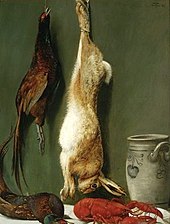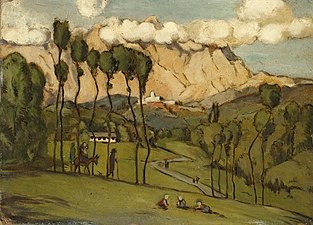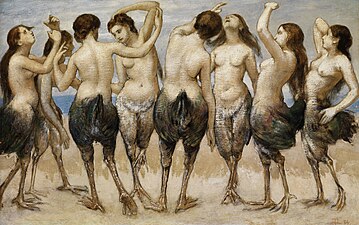Hans Thoma (2 October 1839 – 7 November 1924) was a German painter.
You can help expand this article with text translated from the corresponding article in German. (December 2021) Click [show] for important translation instructions.
|
Hans Thoma | |
|---|---|
 | |
| Born | 2 October 1839 |
| Died | 7 November 1924 Karlsruhe |
| Occupation | Painter, printmaker, graphic artist, visual artist |
| Spouse(s) | Cella Thoma |
Biography
Hans Thoma was born on 2 October 1839 in Bernau, Grand Duchy of Baden, in the Black Forest, Germany.[1] He was the son of a miller and was trained in the basics of painting by a painter of clock faces.[1] He entered the Karlsruhe Academy in 1859, where he studied under Johann Wilhelm Schirmer and Ludwig des Coudres – the latter of which had a major influence on his career.[2] Thoma also studied under Hans Gude, but rebelled against Gude's realism.[3] He subsequently studied and worked, with but indifferent success, in Düsseldorf, Paris, Italy, Munich and Frankfurt, until his reputation became firmly established as the result of an exhibition of some thirty of his paintings in Munich.[4] He died in Karlsruhe in 1924 at the age of 85.
Style
In spite of his studies under various masters, his art has little in common with modern ideas, and is formed partly by his early impressions of the simple idyllic life of his native district, partly by his sympathy with the early German masters, particularly with Albrecht Altdorfer and Lucas Cranach the Elder. In his love of the details of nature, in his precise drawing of outline, and in his predilection for local coloring, he has distinct affinities with the Pre-Raphaelites.[4]
Works
Many of his pictures have found their way into two private collections in Liverpool. A portrait of the artist and two subject pictures, The Guardian of the Valley and Spring Idyll are at the Galerie Neue Meister; Eve in Paradise and The Open Valley at the Städel. Other important pictures of his are Paradise, Christ and Nicodemus, The Flight into Egypt, Charon, Pietà, Adam and Eve, Solitude, Tritons, besides many landscapes and portraits.[4]
He also produced numerous lithographs and pen drawings, and some decorative mural paintings, notably in a café at Frankfurt, and in the music room of the Alfred Pringsheim house in Munich.[4]
Thoma's artwork was favored by Nazis during the Third Reich 1933-1945 and he was listed among official painters.[5] Artworks acquired for Adolf Hitler's planned Führermuseum in Linz included Badende Jünglinge (bathing boys), looted from the Jewish collector Adolf Bensinger in 1939,[6] and Blick auf Mamolsheim, looted from the Jewish collectors Martin and Florence Flersheim.[7] Other artworks by Thoma that were acquired during the Nazi era from Jewish collectors include "Dusk at Lake Garda", looted from the Jewish collector Ottmar Strauss,[8] "Springtime in the Mountains/Children’s Dance," sold under duress in 1938 by Hedwig Ullmann,[9] Sinnendes Mädchen / Frau mit Schimmel (‘Pensive Girl/Women with White Horse’) (Lost Art-ID 302432) looted from the Jewish art collector Smoschewer in 1939[10] and The Rhine at Säckingen in the Black Forest formerly owned by Max Emden.[11] The German Lost Art Database lists several paintings by Thoma.[12]
- Sunday Peace
- Still life with a hare, pheasants and a lobster
- Portrait of Conrad Fiedler
- The Mountains of Carrara
- View of Mamolsheim
- Children with a Herd of Goats
- Eight Dancing Maidens in Bird Costumes
References
External links
Wikiwand in your browser!
Seamless Wikipedia browsing. On steroids.
Every time you click a link to Wikipedia, Wiktionary or Wikiquote in your browser's search results, it will show the modern Wikiwand interface.
Wikiwand extension is a five stars, simple, with minimum permission required to keep your browsing private, safe and transparent.







